Ards prone position - Study guides, Class notes & Summaries
Looking for the best study guides, study notes and summaries about Ards prone position? On this page you'll find 350 study documents about Ards prone position.
Page 4 out of 350 results
Sort by
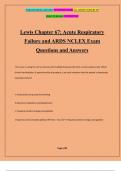
-
Lewis Chapter 67: Acute Respiratory Failure and ARDS NCLEX Exam Questions and Answers
- Exam (elaborations) • 48 pages • 2024
-
- $11.49
- + learn more
Lewis Chapter 67: Acute Respiratory Failure and ARDS NCLEX Exam Questions and Answers The nurse is caring for a 27-yr-old man with multiple fractured ribs from a motor vehicle crash. Which clinical manifestation, if experienced by the patient, is an early indication that the patient is developing respiratory failure? A Tachycardia and pursed lip breathing B Kussmaul respirations and hypotension C Frequent position changes and agitation D Cyanosis and increased capillary refill time - An...
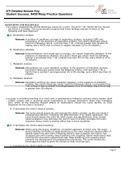
-
ATI Detailed Answer Key Student Success. N4581Resp Practice Questions
- Exam (elaborations) • 20 pages • 2022
-
- $15.99
- 5x sold
- + learn more
ATI Detailed Answer Key Student Success. N4581Resp Practice Questions QUESTIONS AND RATIONALE 1. A nurse is reviewing the arterial blood gas values for a client. The pH is 7.32, PaCO2 48 mm Hg and the HCO3 is 23 mEq/L. The nurse should recognize that these findings indicate of which of the following acid base balances? A. Respiratory acidosis Rationale: A number of conditions can lead to respiratory acidosis, including COPD and pneumonia. In the presence of respiratory acidosis, the cli...

-
HESI CRITICAL CARE EXIT EXAM 2024 SCREENSHOT / CRITICAL CARE HESI EXIT EXAM 2024 ACTUAL EXAM SCREENSHOT ALL 55 QUESTIONS AND CORRECT DETAILED ANSWERS
- Exam (elaborations) • 18 pages • 2024
-
- $12.49
- + learn more
HESI CRITICAL CARE EXIT EXAM 2024 SCREENSHOT / CRITICAL CARE HESI EXIT EXAM 2024 ACTUAL EXAM SCREENSHOT ALL 55 QUESTIONS AND CORRECT DETAILED ANSWERS A client recovering from a percutaneous coronary intervention (PCI) after an acute myocardial infarction is being transferred from the PACU to the Cardiac ICU. Which assessment finding should the PACU nurse inform the healthcare provider of immediately? a. onset of chest pain b. need to apply pressure dressing c. presence of occasional PVC...
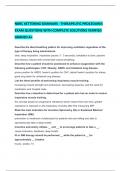
-
NBRC KETTERING SEMINARS - THERAPEUTIC PROCEDURES EXAM QUESTIONS WITH COMPLETE SOLUTIONS VERIFIED GRADED A+
- Exam (elaborations) • 14 pages • 2024
- Available in package deal
-
- $8.99
- + learn more
NBRC KETTERING SEMINARS - THERAPEUTIC PROCEDURES EXAM QUESTIONS WITH COMPLETE SOLUTIONS VERIFIED GRADED A+ Describe the ideal breathing pattern for improving ventilation regardless of the type of therapy being administered. slow, deep inspiration, inspiratory pause (1 - 3 seconds), exhalation is slow, passive and relaxed, relaxed with normal tidal volume breathing. Describe how a patient should be positioned to enhance oxygenation with the following pathologies: CHF, Obesity, ARDS, and Unil...
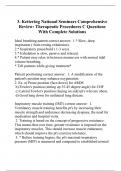
-
3. Kettering National Seminars Comprehensive Review: Therapeutic Procedures C Questions With Complete Solutions
- Exam (elaborations) • 32 pages • 2023
- Available in package deal
-
- $12.99
- + learn more
Ideal breathing pattern correct answer: 1.* Slow, deep inspiration ( from resting exhalation). 2.* Inspiratory pause/hold ( 1-3 secs) 3.* Exhalation is slow, passive and relaxed. 4.* Patient may relax in between maneuvers with normal tidal volume breathing. * Tell patients while giving treatment* Patient positioning correct answer: 1. A modification of the patient's position may enhance oxygenation 2. Ex: a) Prone position (face down) for ARDS b) Fowler's position (sitting up 35-45...
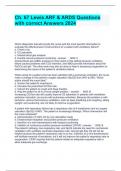
-
Ch. 67 Lewis ARF & ARDS Questions with correct Answers 2024
- Exam (elaborations) • 8 pages • 2024
- Available in package deal
-
- $18.49
- + learn more
Ch. 67 Lewis ARF & ARDS Questions with correct Answers 2024 Which diagnostic test will provide the nurse with the most specific information to evaluate the effectiveness of interventions for a patient with ventilatory failure? a. Chest x-ray b. O2 saturation c. Arterial blood gas analysis d. Central venous pressure monitoring ANS: C Arterial blood gas (ABG) analysis is most useful in this setting because ventilatory failure causes problems with CO2 retention, and ABGs provide information ...
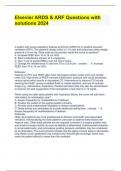
-
Elsevier ARDS & ARF Questions with solutions 2024
- Exam (elaborations) • 6 pages • 2024
- Available in package deal
-
- $14.99
- + learn more
Elsevier ARDS & ARF Questions with solutions 2024 A patient with acute respiratory distress syndrome (ARDS) is on positive pressure ventilation (PPV). The patient's cardiac index is 1.4 L/min and pulmonary artery wedge pressure is 8 mm Hg. What order by the provider would the nurse to question? A. Increase PEEP from 10 to 15 cm H2O. B. Start a dobutamine infusion at 3 mcg/kg/min. C. Give 1 unit of packed RBCs over the next 2 hours. D. Change the maintenance IV rate from 75 to 125 mL/hr. A...
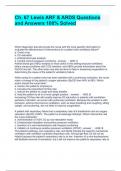
-
Ch. 67 Lewis ARF & ARDS Questions and Answers 100% Solved
- Exam (elaborations) • 8 pages • 2024
- Available in package deal
-
- $16.99
- + learn more
Ch. 67 Lewis ARF & ARDS Questions and Answers 100% Solved Which diagnostic test will provide the nurse with the most specific information to evaluate the effectiveness of interventions for a patient with ventilatory failure? a. Chest x-ray b. O2 saturation c. Arterial blood gas analysis d. Central venous pressure monitoring ANS: C Arterial blood gas (ABG) analysis is most useful in this setting because ventilatory failure causes problems with CO2 retention, and ABGs provide information ab...

-
Critical Care exam 1: Respiratory Practice Questions and Answers. (Graded A)
- Exam (elaborations) • 19 pages • 2023
- Available in package deal
-
- $10.89
- + learn more
1) A nurse is caring for a patient with ARDS. The nurse views the ABG. What value should the nurse report to the physician? pH: 7.35 PaCO2: 26mmhg PaO2:95 HCO3: 22 a) PaCO2 b)pH c)HCO3 d)PaO2 - ANSWER-a The normal range for PaCO2 is 35-45. This patient is experiencing a superimposed respiratory alkalosis likely due to hyperventilation. The nurse should report the PaCO2 to the physician. 2) A nurse must position the patient prone after his diagnosis of acute respiratory distress...
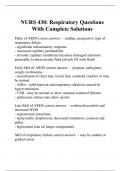
-
NURS 430: Respiratory Questions With Complete Solutions
- Exam (elaborations) • 10 pages • 2023
- Available in package deal
-
- $10.49
- + learn more
Patho of ARDS correct answer: - sudden, progressive type of respiratory failure - significant inflammatory response - increased capillary permeability - alveolar capillary membrane becomes damaged and more permeable to intravascular fluid (alveoli fill with fluid) Early S&S of ARDS correct answer: - dyspnea, tachypnea, cough, restlessness - auscultation of chest may reveal fine, scattered crackles or may be normal - ABGs - mild hypoxia and respiratory alkalosis caused by hyperventilati...

Study stress? For sellers on Stuvia, these are actually golden times. KA-CHING! Earn from your study resources too and start uploading now. Discover all about earning on Stuvia


